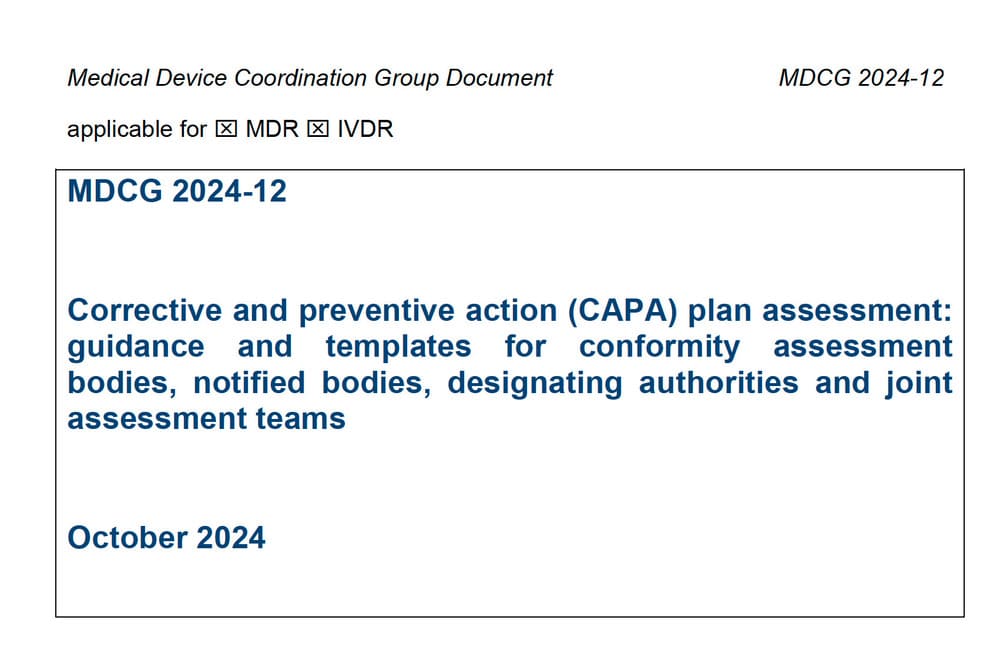
MDCG 2024-12: What It Means for Manufacturers in the Medical Device Industry
Medical devices regulation
The medical device sector is no stranger to stringent regulations, and it’s essential for every player — be it manufacturers, conformity assessment bodies (CABs), or notified bodies (NBs) — to stay on top of these ever-evolving requirements. One of the latest guidance documents, MDCG 2024-12, focuses on Corrective and Preventive Action (CAPA) plans, and while it is primarily directed at regulatory bodies like CABs, NBs, and joint assessment teams (JATs), manufacturers can also benefit greatly from understanding its principles.
Let’s dive into what MDCG 2024-12 entails, why it matters, and how manufacturers can leverage it to enhance their own compliance processes.
1. A Quick Overview of MDCG 2024-12
The Medical Device Coordination Group (MDCG) issued MDCG 2024-12 to offer guidance on CAPA plans that address non-compliances (NCs) identified during regulatory joint assessments. These assessments are conducted as part of the Medical Devices Regulation (MDR) and In Vitro Diagnostic Medical Devices Regulation (IVDR).
The document provides a structured approach to ensuring compliance with EU regulations by offering templates for CAPA plans that help notified bodies handle NCs effectively. Though these templates are not mandatory, using them promotes consistency, clarity, and efficiency when addressing and reviewing NCs.
While the target audience is primarily regulatory bodies, such as notified bodies (NBs) and designating authorities (DAs), the insights contained within MDCG 2024-12 can also benefit manufacturers who wish to align their quality management systems with best practices.
2. Why Should Manufacturers Care?
You might wonder: if this guidance is intended for notified bodies and regulatory authorities, why should manufacturers pay attention to it? The answer is simple: understanding how the bodies that assess and certify your products are themselves regulated gives you an advantage. Here’s how:
a. Get Ahead by Understanding Notified Body Expectations
Notified bodies are the ones responsible for certifying your medical devices and ensuring they meet regulatory requirements. MDCG 2024-12 outlines how these bodies are expected to handle non-compliances during their own assessments, providing transparency into the expectations placed on them.
For manufacturers, this is invaluable. By knowing what standards the NBs are held to, you can better understand the level of scrutiny your devices will face and prepare accordingly. This means that during your own product assessments, you’ll have insight into how non-compliances might be handled and what steps NBs might expect from you to correct them.
b. Strengthen Your Own CAPA Processes
The guidance provided to NBs on CAPA plans is highly relevant to manufacturers, particularly those seeking to improve their quality management systems (QMS). A significant part of MDCG 2024-12 revolves around identifying the root cause of non-compliances and implementing both corrective and preventive actions to eliminate these issues at their source.
Manufacturers can adopt these same principles. For example, when addressing an NC related to a design flaw or a process gap, it’s not enough to simply correct the immediate issue. A robust CAPA process requires you to dig deeper — what caused the problem in the first place? How can similar issues be prevented from recurring? This approach helps ensure not only compliance but also continuous improvement across your operations.
c. Be Ready for Audits
By aligning your internal processes with the CAPA principles outlined in MDCG 2024-12, you’ll be better prepared for assessments and audits by notified bodies. This guidance emphasizes clear documentation, structured corrective actions, and timely follow-ups — all essential elements for a smooth audit process.
Moreover, staying proactive in your compliance efforts can save you time, resources, and stress. Audits can be rigorous, but having a thorough CAPA process in place shows auditors that you take compliance seriously and have already mitigated potential risks.
3. How Manufacturers Can Apply This Guidance
Even though MDCG 2024-12 isn’t explicitly directed at manufacturers, its core principles can be seamlessly integrated into your QMS. Here’s how you can apply the guidance:
- Adopt a Structured CAPA Framework: Use the same structured approach outlined for NBs in your own corrective action plans. For every non-compliance or quality issue, ensure you’re documenting the root cause, taking corrective action, and implementing preventive measures.
- Ensure Traceability and Documentation: Regulatory bodies emphasize the importance of clear, traceable documentation throughout the CAPA process. Manufacturers should adopt similar practices by maintaining clear records of corrective actions and improvements. This also makes future audits smoother and easier to manage.
- Focus on Preventive Action: It’s not just about fixing problems when they occur—taking preventive action is key to avoiding potential non-compliances in the first place. Identify systemic issues early, and put measures in place to prevent them from escalating.
4. Final Thoughts: Proactive Compliance is Key
The MDCG 2024-12 guidance is another reminder of the critical role that regulatory oversight plays in the medical device industry. While it may be primarily aimed at notified bodies and regulatory authorities, manufacturers have much to gain from familiarizing themselves with its content.
Incorporating best practices from this guidance into your own CAPA processes can help you maintain compliance, improve product quality, and ensure patient safety — all while making your interactions with regulatory bodies smoother and more efficient.
So, while MDCG 2024-12 might not have been written with manufacturers in mind, it’s definitely worth your attention. After all, staying ahead in compliance isn’t just about ticking boxes — it’s about creating safer, more reliable medical devices for the market.
We are at your service
Since the arrival of Regulation 2017/745, new requirements are requested and form part of the documentation to be presented to the notified body (e.g. review of the in-depth clinical evaluation, PMS procedure, QC results from validation products, proof of staff skills, etc.).
CSDmed brings its expertise and a methodical approach to its clients, start-ups, manufacturers, importers and distributors of medical devices, thanks to a team of specialized experts and consultants, who will be able to address the MDR transition in its entirety
🔗 Contact us and find out how we can help you.